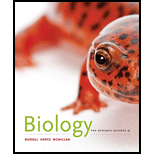
Biology: The Dynamic Science (MindTap Course List)
4th Edition
ISBN: 9781305389892
Author: Peter J. Russell, Paul E. Hertz, Beverly McMillan
Publisher: Cengage Learning
expand_more
expand_more
format_list_bulleted
Question
Chapter 41, Problem 10TYK
Summary Introduction
Introduction:
Temperature is detected by thermoreceptors in the form of cold or heat. The nociceptors are pain receptors present in the skin and certain internal organs of body. The pain receptors receive signals from damaged skin and transmit those signals to the brain. They are non-adaptive, that is, a person cannot bear extreme pain for a very long period of time. Analgesics are used to cure pain temporarily.
Expert Solution & Answer
Trending nowThis is a popular solution!

Students have asked these similar questions
its an open book assignemnt
Describe two different gene regulation mechanisms involving methylation
What is behavioral adapt
Chapter 41 Solutions
Biology: The Dynamic Science (MindTap Course List)
Ch. 41.1 - Prob. 1SBCh. 41.1 - Prob. 2SBCh. 41.2 - Prob. 1SBCh. 41.2 - What properties qualify proprioceptors as...Ch. 41.3 - What vibration-detecting systems are found in...Ch. 41.3 - Prob. 2SBCh. 41.4 - For vertebrate photoreception, define: (a)...Ch. 41.5 - How do we distinguish different kinds of smells?Ch. 41.5 - Prob. 2SBCh. 41.6 - Prob. 1SB
Ch. 41.7 - What are three ways electroreceptors are used in...Ch. 41 - An ambulance siren in close proximity to a dog can...Ch. 41 - Prob. 2TYKCh. 41 - Which of the following situations is associated...Ch. 41 - Prob. 4TYKCh. 41 - Prob. 5TYKCh. 41 - The eyes of vertebrates and cephalopods are...Ch. 41 - Which of the following events does not occur...Ch. 41 - Prob. 8TYKCh. 41 - Prob. 9TYKCh. 41 - Prob. 10TYKCh. 41 - Discuss Concepts In owls and many other birds of...Ch. 41 - Prob. 12TYKCh. 41 - Prob. 13TYKCh. 41 - Prob. 14TYKCh. 41 - Prob. 15TYKCh. 41 - Prob. 1ITDCh. 41 - Prob. 2ITDCh. 41 - Prob. 3ITD
Knowledge Booster
Similar questions
- 22. Which of the following mutant proteins is expected to have a dominant negative effect when over- expressed in normal cells? a. mutant PI3-kinase that lacks the SH2 domain but retains the kinase function b. mutant Grb2 protein that cannot bind to RTK c. mutant RTK that lacks the extracellular domain d. mutant PDK that has the PH domain but lost the kinase function e. all of the abovearrow_forwardWhat is the label ?arrow_forwardCan you described the image? Can you explain the question as well their answer and how to get to an answer to an problem like this?arrow_forward
- Describe the principle of homeostasis.arrow_forwardExplain how the hormones of the glands listed below travel around the body to target organs and tissues : Pituitary gland Hypothalamus Thyroid Parathyroid Adrenal Pineal Pancreas(islets of langerhans) Gonads (testes and ovaries) Placentaarrow_forwardWhat are the functions of the hormones produced in the glands listed below: Pituitary gland Hypothalamus Thyroid Parathyroid Adrenal Pineal Pancreas(islets of langerhans) Gonads (testes and ovaries) Placentaarrow_forward
- Describe the hormones produced in the glands listed below: Pituitary gland Hypothalamus Thyroid Parathyroid Adrenal Pineal Pancreas(islets of langerhans) Gonads (testes and ovaries) Placentaarrow_forwardPlease help me calculate drug dosage from the following information: Patient weight: 35 pounds, so 15.9 kilograms (got this by dividing 35 pounds by 2.2 kilograms) Drug dose: 0.05mg/kg Drug concentration: 2mg/mLarrow_forwardA 25-year-old woman presents to the emergency department with a 2-day history of fever, chills, severe headache, and confusion. She recently returned from a trip to sub-Saharan Africa, where she did not take malaria prophylaxis. On examination, she is febrile (39.8°C/103.6°F) and hypotensive. Laboratory studies reveal hemoglobin of 8.0 g/dL, platelet count of 50,000/μL, and evidence of hemoglobinuria. A peripheral blood smear shows ring forms and banana-shaped gametocytes. Which of the following Plasmodium species is most likely responsible for her severe symptoms? A. Plasmodium vivax B. Plasmodium ovale C. Plasmodium malariae D. Plasmodium falciparumarrow_forward
arrow_back_ios
SEE MORE QUESTIONS
arrow_forward_ios
Recommended textbooks for you
 Human Physiology: From Cells to Systems (MindTap ...BiologyISBN:9781285866932Author:Lauralee SherwoodPublisher:Cengage LearningBasic Clinical Lab Competencies for Respiratory C...NursingISBN:9781285244662Author:WhitePublisher:Cengage
Human Physiology: From Cells to Systems (MindTap ...BiologyISBN:9781285866932Author:Lauralee SherwoodPublisher:Cengage LearningBasic Clinical Lab Competencies for Respiratory C...NursingISBN:9781285244662Author:WhitePublisher:Cengage Biology: The Dynamic Science (MindTap Course List)BiologyISBN:9781305389892Author:Peter J. Russell, Paul E. Hertz, Beverly McMillanPublisher:Cengage Learning
Biology: The Dynamic Science (MindTap Course List)BiologyISBN:9781305389892Author:Peter J. Russell, Paul E. Hertz, Beverly McMillanPublisher:Cengage Learning
 Comprehensive Medical Assisting: Administrative a...NursingISBN:9781305964792Author:Wilburta Q. Lindh, Carol D. Tamparo, Barbara M. Dahl, Julie Morris, Cindy CorreaPublisher:Cengage Learning
Comprehensive Medical Assisting: Administrative a...NursingISBN:9781305964792Author:Wilburta Q. Lindh, Carol D. Tamparo, Barbara M. Dahl, Julie Morris, Cindy CorreaPublisher:Cengage Learning

Human Physiology: From Cells to Systems (MindTap ...
Biology
ISBN:9781285866932
Author:Lauralee Sherwood
Publisher:Cengage Learning

Basic Clinical Lab Competencies for Respiratory C...
Nursing
ISBN:9781285244662
Author:White
Publisher:Cengage

Biology: The Dynamic Science (MindTap Course List)
Biology
ISBN:9781305389892
Author:Peter J. Russell, Paul E. Hertz, Beverly McMillan
Publisher:Cengage Learning


Comprehensive Medical Assisting: Administrative a...
Nursing
ISBN:9781305964792
Author:Wilburta Q. Lindh, Carol D. Tamparo, Barbara M. Dahl, Julie Morris, Cindy Correa
Publisher:Cengage Learning
